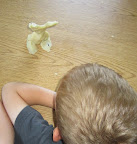 Oscar Pistorius attracted our attention in both the 2012 Olympic and Paralympic Games. First, he fought long and hard to become the first amputee to run in Olympic events. Then, during competition in the Paralympics he expressed concerns that other Paralympic runners were using the same assistive technology as he does—“blades”—to a competitive advantage.
Oscar Pistorius attracted our attention in both the 2012 Olympic and Paralympic Games. First, he fought long and hard to become the first amputee to run in Olympic events. Then, during competition in the Paralympics he expressed concerns that other Paralympic runners were using the same assistive technology as he does—“blades”—to a competitive advantage.
So… what are these blades? How are they used? Do they confer a competitive advantage? If so, how? Find out in this installment of the NBC Learn/NSF videos series Science of the Summer Olympics—The Strength and Flexibility of Oscar Pistorius. Use the NSTA-developed lessons to guide inquiry investigations through hands-on and Internet research.
We hope you try them out. If you do, please leave comments below each posting about how well the information worked in real-world classrooms. And if you had to make significant changes to a lesson, we’d love to see what you did differently, as well as why you made the changes. Leave a comment, and we’ll get in touch with you with submission information.
–Judy Elgin Jensen
Image of Oscar Pistorius in 200-m Paralympics final courtesy of Karli Watson
Video
“The Strength and Flexibility of Oscar Pistorius” features Oscar Pistorius, a Paralympics Gold Medalist, who qualified to sprint in the Summer 2012 Olympics. Various researchers, including biomechanical engineer Rory Cooper and physical therapist Justin Laferrier at the University of Pittsburgh, explain the physics involved in using prosthetics designed especially for sprinting, as well as the biomechanics involved to compensate for the loss of active body components. Also briefly discussed in this video is whether or not Oscar’s prosthetics give him a competitive advantage over other sprinters.
Lesson plans
Two versions of the lesson plans help students build background and develop questions they can explore regarding how the body adapts to assistive technologies as well as the potential competitive advantage in using them. Both include strategies to support students in their own quest for answers and strategies for a more focused approach that helps all students participate in hands-on inquiry.
SOTSO: The Strength and Flexibility of Oscar Pistorius models how students might investigate the impact of body motions on running speed.
SOTSO: The Strength and Flexibility of Oscar Pistorius, An Engineering Perspective models a research effort to find out what is known about a design solution.
You can use the following form to e-mail us edited versions of the lesson plans:
[contact-form 2 “ChemNow]



 In Memoriam: sadly, we report the passing of Irwin Slesnick, whose many contributions to NSTA and the broader realm of science education include the NSTA Press books Adventures in Paleontology and Clones, Cats, and Chemicals. Please see an
In Memoriam: sadly, we report the passing of Irwin Slesnick, whose many contributions to NSTA and the broader realm of science education include the NSTA Press books Adventures in Paleontology and Clones, Cats, and Chemicals. Please see an 



 Children like to make models of their family pets. When children find their larger playdough models won’t stand up, ask them, “What helps you to stand?”, beginning a discussion about bones. Pipe cleaners or sticks representing the skeleton can be added to the models to make them able to stand. In the
Children like to make models of their family pets. When children find their larger playdough models won’t stand up, ask them, “What helps you to stand?”, beginning a discussion about bones. Pipe cleaners or sticks representing the skeleton can be added to the models to make them able to stand. In the 
 I recently started teaching in an elementary school. When I first walked into my classroom, I was surprised that there were no supplies or equipment for teaching science. My colleagues said that the requisitions and orders were all placed last year, the budget is tight, but eventually I can request supplies for next year. What can I do now?
I recently started teaching in an elementary school. When I first walked into my classroom, I was surprised that there were no supplies or equipment for teaching science. My colleagues said that the requisitions and orders were all placed last year, the budget is tight, but eventually I can request supplies for next year. What can I do now? Oscar Pistorius attracted our attention in both the 2012 Olympic and Paralympic Games. First, he fought long and hard to become the first amputee to run in Olympic events. Then, during competition in the Paralympics
Oscar Pistorius attracted our attention in both the 2012 Olympic and Paralympic Games. First, he fought long and hard to become the first amputee to run in Olympic events. Then, during competition in the Paralympics  The National Science Education Standards use the word “inquiry” in two ways. It was to be a form of content while also being a way science must be taught. Some argue that the term inquiry needs to have “scientific” in front of it (that is, scientific inquiry) before it has real meaning and use in science education. Such varying positions certainly can cause communication problems and often interfere with success with current reforms.
The National Science Education Standards use the word “inquiry” in two ways. It was to be a form of content while also being a way science must be taught. Some argue that the term inquiry needs to have “scientific” in front of it (that is, scientific inquiry) before it has real meaning and use in science education. Such varying positions certainly can cause communication problems and often interfere with success with current reforms.